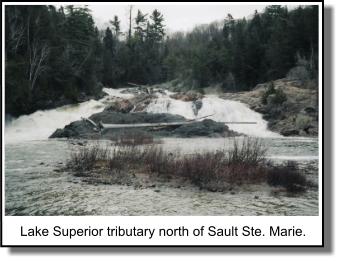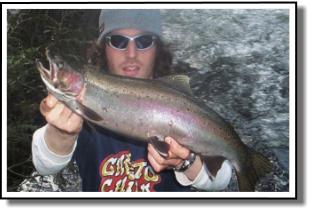Spring Steelhead
Every angler tries it and often most give up. Itís
slippery, damp, and often leaves you frustrated and
fishless. Fishermen and women spend countless hours on
the banks of Great Lake tributaries in search of
spawning rainbow trout each spring. Mouths of rivers
where steelhead begin to congregate in late winter
become an open water hotspot at ice out. As the water
begins to warm steelhead will begin their spring run up
rivers to spawn. Casting at the same pool or drifting a
current break for hours with minimal results, often
steers anglers to fish for other species. Little do most
anglers realize; spring is the hottest time of the year
with amazing numbers of fish accessible to anglers
willing to put in the time.
Water Levels and Clarity  The
level of the rivers water is often the key to success. A
good rain will trigger a run of fish into a river but
steelhead are often still difficult to locate due to
faster, dirtier and deeper water. A day or two after a
heavy rainfall the river levels will begin to start
slowly dropping back down forcing the fish to start
holding in more predictable areas. Smaller rivers I like
1-2 feet of water clarity and larger rivers 3 feet or
more. The
level of the rivers water is often the key to success. A
good rain will trigger a run of fish into a river but
steelhead are often still difficult to locate due to
faster, dirtier and deeper water. A day or two after a
heavy rainfall the river levels will begin to start
slowly dropping back down forcing the fish to start
holding in more predictable areas. Smaller rivers I like
1-2 feet of water clarity and larger rivers 3 feet or
more. Use Your Head Your eyes and ears are natural fishing tools anglers often do not use. Polarized glasses take the glare off the water giving our eyes the ability to penetrate the waterís surface. Now you can look for submerged rocks, logs, undercut banks, brush piles, deep poles and often timeís actual fish. When water levels begin to drop and late spawning fish are still lurking in the river. Use your ears and listen for the sounds of splashing fish, running up small sets of rapids or shallow bends in the river. When you do spot a fish do not panic. It is not going far anytime soon. Sneak up on the fish or sit and wait for that struggling rainbow to make one last push over the rapids and into the pool you are excitedly stalking. This is absolutely one of the most exciting ways to hook any species but what is especially exhilarating about Great Lakes Steelhead is their absolute raw power and high flying antics that begin immediately after hook up. Drifting spawn bags under a float is a technique both novice and avid anglers use. It is a simple rig consisting of a bobber stop, slip float, split shot sinkers and finally a red octopus hook. Cast this rig upstream, and then reel up so your line is tight. Follow your float with your rod tip. Once your line begins to sweep across the river because your line has completely tightened up, open up your bail and cup your spool with your free hand. Let line out with your hand to match the current speed and continue your drift as far as possible. Once a strike is visible or felt, close your bail with a quick flip from your free hand and tighten up the line to the fish before firmly sweeping your rod tip back. Another option instead of cupping your reel would be to deactivate your anti-reverse button on the bottom of your spinning reel and back reel to give the fish line. Bounce Around Bouncing the bottom always produces giant steelhead each spring. In larger rivers I opt for a 3-way rig because of the deeper and faster moving water. I use a 6-10 inch leader of 6# mono tied to a pencil sinker which I bend into a banana shape with my hands. To save time use a lighter line to attach your sinker. Snags will now only break your sinker off and not the whole 3 way rig. On the business end a 3 to 6 foot leader of 8-10# mono or fluorocarbon is tied to a red octopus hook. Another good tip for saving time is to pre tie your leaders onto several 3 way swivels before you go fishing and always bring pliers to cut down your sinkers to a lighter weight if snags become frequent. In smaller, slower and clearer water usually a split shot rig is the easiest and best for this situation. Choose a split shot that will allows your bait to bounce along bottom keeping contact throughout your drift. 3 Rís (Rod, Reel, Roe) Float rods used are generally in the 10-12 foot range. These rods are excellent shock absorbers that allows float fisherman to use extra light line. The bouncing method calls for slightly shorter rod in the 7 to 9 foot range and seem to always be a little bit stiffer than the float rods. Often small rivers have over grown bushes with minimal room to fight and land fish. The traditional 7 to 12 foot steelhead rods can definitely become a handicap for an angler in these small water situations. I switch to my 6Ē6 Fenwick HMX which I normally use to jig up walleyes. This rod is sensitive and has a lot of backbone for fighting fish in small rivers. Reels used for floating and bouncing bottom should have a high line capacity because of the amount of line that will be used. Snags are inevitable and line damage with be frequent from rubbing rocks and bottom. Roe bags tied with various coloured mesh is my favourite bait during spring. Bright colours for dirty, stained water and natural colours in clear water work best. Other bait options include crawlers, wax worms, wigglers, hair jigs and always casting hardware.
Back to Front Page of Magazine
Get North!
Fishing
Lodge Classifieds
|


